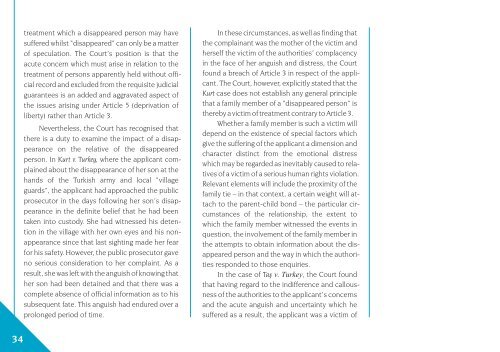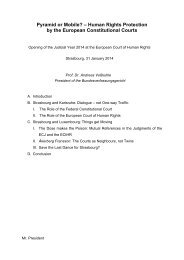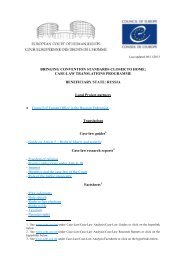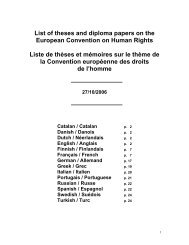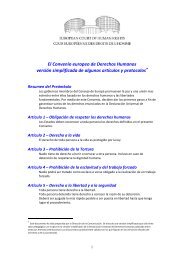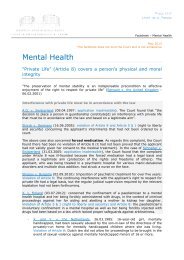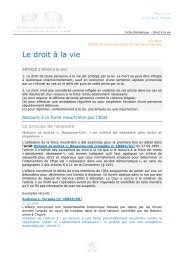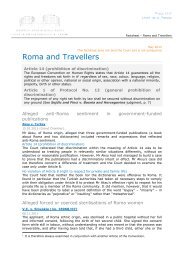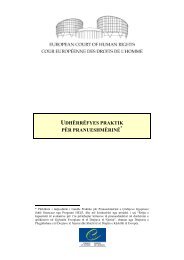The prohibition of torture - European Court of Human Rights
The prohibition of torture - European Court of Human Rights
The prohibition of torture - European Court of Human Rights
You also want an ePaper? Increase the reach of your titles
YUMPU automatically turns print PDFs into web optimized ePapers that Google loves.
treatment which a disappeared person may have<br />
suffered whilst “disappeared” can only be a matter<br />
<strong>of</strong> speculation. <strong>The</strong> <strong>Court</strong>’s position is that the<br />
acute concern which must arise in relation to the<br />
treatment <strong>of</strong> persons apparently held without <strong>of</strong>ficial<br />
record and excluded from the requisite judicial<br />
guarantees is an added and aggravated aspect <strong>of</strong><br />
the issues arising under Article 5 (deprivation <strong>of</strong><br />
liberty) rather than Article 3.<br />
Nevertheless, the <strong>Court</strong> has recognised that<br />
there is a duty to examine the impact <strong>of</strong> a disappearance<br />
on the relative <strong>of</strong> the disappeared<br />
person. In Kurt v. Turkey, where the applicant complained<br />
about the disappearance <strong>of</strong> her son at the<br />
hands <strong>of</strong> the Turkish army and local “village<br />
guards”, the applicant had approached the public<br />
prosecutor in the days following her son’s disappearance<br />
in the definite belief that he had been<br />
taken into custody. She had witnessed his detention<br />
in the village with her own eyes and his nonappearance<br />
since that last sighting made her fear<br />
for his safety. However, the public prosecutor gave<br />
no serious consideration to her complaint. As a<br />
result, she was left with the anguish <strong>of</strong> knowing that<br />
her son had been detained and that there was a<br />
complete absence <strong>of</strong> <strong>of</strong>ficial information as to his<br />
subsequent fate. This anguish had endured over a<br />
prolonged period <strong>of</strong> time.<br />
In these circumstances, as well as finding that<br />
the complainant was the mother <strong>of</strong> the victim and<br />
herself the victim <strong>of</strong> the authorities’ complacency<br />
in the face <strong>of</strong> her anguish and distress, the <strong>Court</strong><br />
found a breach <strong>of</strong> Article 3 in respect <strong>of</strong> the applicant.<br />
<strong>The</strong> <strong>Court</strong>, however, explicitly stated that the<br />
Kurt case does not establish any general principle<br />
that a family member <strong>of</strong> a “disappeared person” is<br />
thereby a victim <strong>of</strong> treatment contrary to Article 3.<br />
Whether a family member is such a victim will<br />
depend on the existence <strong>of</strong> special factors which<br />
give the suffering <strong>of</strong> the applicant a dimension and<br />
character distinct from the emotional distress<br />
which may be regarded as inevitably caused to relatives<br />
<strong>of</strong> a victim <strong>of</strong> a serious human rights violation.<br />
Relevant elements will include the proximity <strong>of</strong> the<br />
family tie – in that context, a certain weight will attach<br />
to the parent-child bond – the particular circumstances<br />
<strong>of</strong> the relationship, the extent to<br />
which the family member witnessed the events in<br />
question, the involvement <strong>of</strong> the family member in<br />
the attempts to obtain information about the disappeared<br />
person and the way in which the authorities<br />
responded to those enquiries.<br />
In the case <strong>of</strong> Ta , the <strong>Court</strong> found<br />
that having regard to the indifference and callousness<br />
<strong>of</strong> the authorities to the applicant’s concerns<br />
and the acute anguish and uncertainty which he<br />
suffered as a result, the applicant was a victim <strong>of</strong><br />
34


